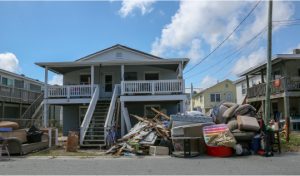Betting on Resilience

Mobilizing Private Investment to Finance Disaster Resistance
BY PORTER GRAHAM, LOCAL GOVERNMENT AFFAIRS DIRECTOR
The Problem: Resilient Infrastructure Costs a Lot
In June 2019, the Institute for Sustainable Government’s Center for Climate Integrity released the first comprehensive, community-level cost estimate for armoring America’s coastal public infrastructure where threatened by projected sea-level rise. Employing conservative projections assuming aggressive carbon emissions reduction scenarios to capture a low-range forecast of sea-level rise, the study developed cost projections for the construction of coastal seawalls to protect transportation infrastructure, public utilities, port facilities, drinking water supply and storm water systems from projected 2040 flood hazard conditions. North Carolina came in third in estimated total cost in the contiguous United States, facing an about $34.8 billion obligation. Equating to about 70 percent of North Carolina’s total government spending for Fiscal Year 2018, this figure reflects the staggering disproportion at which public capital resources across the United States compare to the cost of constructing climate-resilient infrastructure.
Researchers at the University of Massachusetts investigating potential financing mechanisms for resilience initiatives within the City of Boston’s Imagine Boston 2030 comprehensive plan concluded in 2018 that maximum conceivable contributions from federal and state sources would offset at most 60 percent of “near to mid-term” projects’ $2.4 billion costs. Their findings contribute to a series of studies undertaken by various coastal cities that document the inadequacy of state and federal subsidies and conventional tax and fee financing to climate adaptation plans at the municipal level. With coastal cities across the U.S. increasingly attentive to the reality of resilience-related additional capital demands estimated in the hundreds of billions by the Federal Reserve Bank of San Francisco, regional discussions among community stakeholders as to the mechanics of mobilizing supplemental private investment signal a new cutting edge in managing climate change. Consensus is emerging as to the major variables inherent in financing a resilient America, with properly valuing climate risk and incentivizing private investment in delayed, diffuse returns among the primary obstacles and financial innovations like resilience bonds among the primary opportunities.
Financial Risk Spurs Innovation
With about $268 billion in damage from hurricanes Harvey, Maria, and Irma alone, 2017 is the costliest U.S. hurricane season on record. As the increasing concentration of infrastructure in coastal regions magnifies the potential for even greater future costs, the importance of developing metrics to adequately anticipate the financial scale of storm events is clear. But systemic defects in the insurance industry’s capacity for accurate risk-pricing fundamentally limit the present power of insurance costs to project climate vulnerability and promote its mitigation. The National Flood Insurance Program (NFIP), which currently underwrites over five million policies, intentionally underrepresents flood risk to contain premium costs by broadly aggregating covered properties into approximate risk categories and employing inadequately detailed Flood Insurance Rate Maps informed by obsolete data. This induces massive insurance market distortions political obstacles to the correction of which Congress has proven repeatedly unable to overcome. While private insurers employ more nuanced mapping and have developed very sophisticated modeling capabilities, market disincentives resulting from the preponderance of artificially inexpensive, actuarially unsound NFIP options limit their issuance of properly risk-adjusted policies, sometimes precipitating their withdrawal from the market altogether. But demand for prudent approaches to valuing climate-related risks has spurred responses elsewhere in the financial sector.
Credit rating agencies have recently begun to refine their ability to incorporate climate vulnerabilities into the pricing of financial assets like municipal bonds. Moody’s July 2019 acquisition of a majority stake in Four Twenty Seven—a provider of market intelligence on the economics of climate change—was widely interpreted as an indication that large financial services firms are preparing to assume their anticipated role as principal arbiters of climate-related financial risks. Bloomberg recently published the results of its analysis of a series of due diligence questionnaires prepared by municipal bond underwriters to disclose risks associated with debt issuances by various municipalities in coastal Florida, reporting that a majority featured new language on “storm-related risks or climate change.” A marked intensification in the rigor and specificity of such disclosure requirements would present a problem for municipalities whose ability to satisfy bond obligations derives from revenue susceptible to storm events, such as from seasonal tourism. Standard & Poor’s reported in July 2019 that “credit ratings analysts are increasingly exploring [these] questions in meetings with local officials,” quoting Honolulu Mayor Kirk Caldwell’s testimony before the U.S. Senate Democrats’ Special Committee on Climate Risks that “the analysts say, ‘we’re rating your bonds, and are you going to be able to pay them back given what’s occurring in your city?’”
Finding a Solution: Resilience Bonds
The deterioration and obsolescence of America’s critical infrastructure and the scant availability of federal funding to offset the cost of improvements are old news to local governments, whose ease in dedicating large up-front investments in public infrastructure projects’ delayed returns often barely exceeds that of the private sector. But the hazard posed by increased borrowing costs due to heightened sensitivity to climate-related exposure among bond investors and rating agencies represents a new, imminent, nonregulatory incentive to begin practical resilience planning. Addressing widespread indication that investor demand for more accurate risk-pricing may precipitate credit rating downgrades and exacerbate capital shortfalls in infrastructure financing, the White House Office of Management and Budget emphasized the importance of developing “diverse financial tools” to “achieve long-term resilience with less dependence on Federal funds.” One financial tool essential to this endeavor’s progress involves the restructuring of an existing high-yield insurance-linked security already familiar to North Carolina, the catastrophe (CAT) bond.
In January 2019, the North Carolina Insurance Underwriting Association (NCIUA) sponsored a CAT bond to finance $450 million in reinsurance protection for North Carolina’s Coastal Property Insurance Pool—a tax-exempt association of insurers who compose the market of last resort for homeowner, dwelling and commercial fire protection policies in eighteen coastal counties. CAT bonds allow insurance companies to transfer to investors the risks of significant natural catastrophes and thereby potentially indemnify damages exceeding the revenue they derive from premiums. CAT bonds differ structurally from conventional municipal bonds in their incorporation of a predetermined loss threshold, operating for a predetermined period of time called the bond term, at which the sponsor of the bond retains the principal invested. If the loss threshold is not met by the maturity date of the bond term, the sponsor must repay the investors’ principal. Throughout the bond term, the investors collect coupon payments including their share of premiums paid by the sponsor at a rate proportional to the catastrophe risk and also of the interest generated by investment of the collateral in very low risk securities like U.S. Treasuries. These transactions are facilitated by one or more investment banks referred to as the bond issuers.
In other words, CAT bonds allow insurance companies to pay investors to offer collateral guaranteeing their ability to issue policies despite the potential for a catastrophic loss of a particular magnitude and investors to bet that a loss of this magnitude will not take place. If the catastrophe occurs, the insurance company can use the collateral to pay its policyholders; if it does not, the investors get the collateral back with a handsome interest and premium dividend. CAT bonds are a high-risk asset class, but remain attractive to institutional investors like hedge funds due to consistent five to seven percent yields generally insulated from wider market performance. The global CAT bond market reached $36.6 billion in 2018. CAT bonds importantly differ from flood insurance in that the accuracy of their pricing does not come at the expense of their marketability. The viability of CAT bonds consists in catastrophe risk modeling firms’ employment of sophisticated simulations constructed from large sets of diverse and mutually-informative quantitative variables, not historical data profiling a specific peril in isolation. By providing a mechanism to monetize for capital market consumption the absence of catastrophic damages due to natural happenstance, CAT bonds can be innovatively restructured to similarly monetize the intentional avoidance of catastrophic damages via resilience projects.
In September 2019, the European Bank for Reconstruction and Development (EBRD) sponsored the world’s first resilience bond—a $700 million issuance underwritten jointly by BNP Paribas, Goldman Sachs, and Skandinaviska Enskilda Banken AB to help finance EBRD’s €7 billion portfolio of climate resilience projects. Resilience bonds operate relative to CAT bonds somewhat like progressive health insurance operates relative to life insurance. Whereas traditional CAT bonds retrogressively indemnify losses incurred from a catastrophic event, resilience bonds progressively mitigate losses before the catastrophe occurs via a rebate structure which monetizes the insurance value that resilience projects create. The issuance of a resilience bond requires comparison of the relative risk of losses satisfying predetermined parameters with and without the sponsor’s completion of a planned resilience project. The resilience bond is initially issued with coupon payments reflecting the original, pre-project risk. Upon completion of the project or of project stages during the bond term, the premium rates and coupon payments are adjusted to reflect the reduction of risk to the collateral, creating an insurance savings that can be withdrawn by the sponsor and applied to project costs that have been securitized via municipal bonds and other conventional instruments to provide immediate capital for financing the project. These new instruments deliver a mechanism whereby national, state and potentially even local governmental entities can secure significant private sector financing for infrastructure improvements otherwise financially infeasible. Resilience bonds can be designed with multiple cosponsors to capture the diffuse risk-reduction benefits accruing from a resilience project to a variety of stakeholders with vulnerable insurable assets, each of whom could not alone afford premiums adequate to a bond of the scale sufficient to finance effective mitigation projects.
For example, the seawalls the Institute for Sustainable Government’s Center for Climate Integrity forecast as necessary to protect North Carolina’s coastal infrastructure would result in rigorously quantifiable risk reductions to a variety of physical assets owned by governmental and quasi-public entities like counties, municipalities, utilities and port and transit authorities. Each entity could participate in resilience bond sponsorship to finance a seawall construction project by committing a share of premium costs proportional to the exposure of their particular assets. Investment banks would engage catastrophe modeling experts to develop baseline and post-project risk profiles and design CAT-type bond paradigms appropriate to the generation of investments on a scale necessary for insurance savings rebates commensurate with project costs. The risk reductions achievable at progressive stages of seawall construction would be captured in predetermined adjustments of coupon payments to investors. Upfront capital for project costs would be financed via multiple issuances of additional sets of traditional securities like revenue bonds guaranteed by the rebates the sponsors will receive. As the seawalls are constructed, the rebates accrue and the revenue bond obligations are satisfied.
The global fanfare accompanying EBRD’s offering illustrates the considerable enthusiasm surrounding resilience bonds in public and private quarters despite their technical complexity. Using capital markets to create value from the hazards posed by natural catastrophes, and then leveraging that value to avoid the same hazards, is certainly an exciting and encouraging proposition. As the broader success of resilience bonds depends on investor confidence in the integrity of the underlying risk modeling, additional research into scenarios more complex than coastal flooding is needed. Future resilience bond initiatives’ successes and failures demand attention from experts in academic, governmental, and finance settings to secure a viable path to their wider market acceptance. If we are to continue enjoying the many benefits of life in coastal communities, we must ensure that advances in resilient construction technologies and materials prove possible on scales larger than public financing alone can support. Thought of the sort behind resilience bonds is crucial to this endeavor.



